
|
|

| |
In 1982/1983 Daimler embarked on a project to prepare the DS420 for sale in the USA and this webpage has the story. The text of this webpage was, in adapted form and with fewer illustrations, also published as an article in The Driving Member, the magazine of the Daimler and Lanchester Owners' Club, in its March 2021 issue. A copy of that article is shown on the page with English language magazine articles.
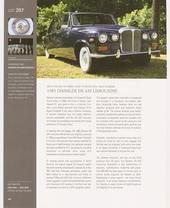
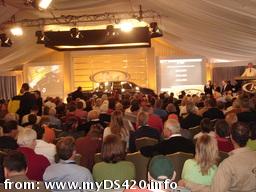 In March 2008 half a dozen pictures of an auction held in Florida, USA.
were sent to me by Bob Boston, fellow DS420 enthusiast from Atlanta Ga.
For sale was a rather strange looking Daimler DS420,
with a still stranger description in the auction catalogue:
"... one of only two four-door saloons
intended for royal use in North America ..."
and even:
"... this Daimler was not originally built with a rear trunk..."
The most striking details visible on the outside of the car
were its MG-B style tail lights.
The trunk/boot however,
had definitely left the factory attached to the rest of the car,
despite the bizarre nonsense in the catalogue.
But many small details were, like the tail lights, "deviant".
And the original engine had been replaced with a large Chevrolet 350.
In March 2008 half a dozen pictures of an auction held in Florida, USA.
were sent to me by Bob Boston, fellow DS420 enthusiast from Atlanta Ga.
For sale was a rather strange looking Daimler DS420,
with a still stranger description in the auction catalogue:
"... one of only two four-door saloons
intended for royal use in North America ..."
and even:
"... this Daimler was not originally built with a rear trunk..."
The most striking details visible on the outside of the car
were its MG-B style tail lights.
The trunk/boot however,
had definitely left the factory attached to the rest of the car,
despite the bizarre nonsense in the catalogue.
But many small details were, like the tail lights, "deviant".
And the original engine had been replaced with a large Chevrolet 350.
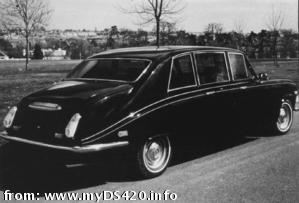 Bob's photos made me think of an illustration on page 302
in Brian Long's well known book
"Daimler and Lanchester,
A Century of Motoring History".
The caption in that book says: "With the North American market in mind,
this prototype was built late in 1984" -actually it was 1983-.
But the DS420 was never sold in the USA,
which made the situation even more intriguing.
Therefore I decided to investigate this further during a
visit to the Jaguar Daimler Heritage Trust archive.
Bob's photos made me think of an illustration on page 302
in Brian Long's well known book
"Daimler and Lanchester,
A Century of Motoring History".
The caption in that book says: "With the North American market in mind,
this prototype was built late in 1984" -actually it was 1983-.
But the DS420 was never sold in the USA,
which made the situation even more intriguing.
Therefore I decided to investigate this further during a
visit to the Jaguar Daimler Heritage Trust archive.
The JDHT archivist came up with a one-foot pile of notes,
left by the late Keith Cambage,
who headed the limousine operations at Browns Lane after
the Vanden Plas factory in Kingsbury/London closed in 1979:
"That might have what you are looking for".
Now the story about "the American limousine" project started to unfold.
The American market has always been very important for Jaguar. But its regulations and legal requirements are a world on its own, and the DS420 was never designed to meet them. In fact, in other files in the JDHT archives I had come across several letters from potential American customers inquiring about the possibility to purchase a DS420 for use in the USA, and they all received the same answer that the DS420 in its current form did not meet the American regulations, and that the company has no plans to produce a compliant vehicle in the foreseeable future. There even are letters from a tenaciously interested person who explicitly described a DS420 in the USA that he knew about, and Jaguar answered that that particular car was sold to an address outside the USA, and that it was unknown how the current owner had managed to get it registered in the US. But all these letters were from the seventies.
Despite all the regulatory hassles, a few DS420 cars were able to sneak into the US in the early eighties. In 1983 limo no. 200423 was sent to San Francisco's Jaguar dealership as a "tax free sale". The dealership was owned by Mr. Kjell Qvale, who is also known as the person behind the Jensen-Healey, and the founder of the Pebble Beach Concours. Mr. Qvale bought the limo for his personal use, and it seems that he was influential enough to get it registered in the US. Later, this car was owned for many years by club member Don Wright in Tulsa Ok, and then by car collector Garrett Capune.
Another DS420 (no. 1M20053, with a toilet under the rear seat!), was delivered in London in 1971 to the famous billionaire Howard Hughes. It showed up in the USA some ten years later, then owned by Bikram Choudhury, who later became a well known yoga franchise entrepreneur. Its current owner (2020) is in the Phoenix Az. area. We have an entire webpage on that Howard Hughes' car. I also found a note related to an embassy car, but no further details on that one.
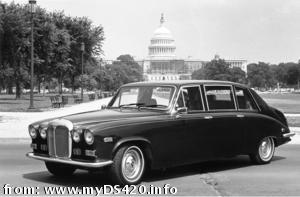
|
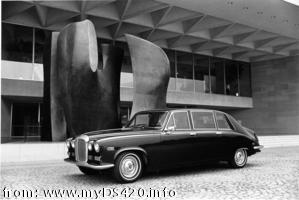
|
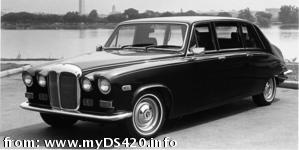
|
These B&W photos, and the next row, |
Not many of the early DS420 cars were sold outside the UK, although the customer list of the ones that were exported reads like a "Who's Who" of Royalty and Heads of State. The printed price lists of that era never failed to mention that "Every effort is made to meet individual requirements", and that the already extensive list of options "only details the extras most often requested". But there is a big difference between adaptations to please a wealthy but demanding customer, and adaptations to meet legal requirements in various countries. The latter category gives an interesting look back at how fragmented Europe was in those days, and how cumbersome it must have been for manufacturers like Jaguar to comply: cars for The Netherlands required specially muted horns, France required yellow headlamps, Italy wanted additional side lamps on the front wings, and the pedestrian-slicing Flying D on the grille was banned in many countries. That list goes on and on. It was obvious that the large scale adaptations required for the US market, were a major hurdle.
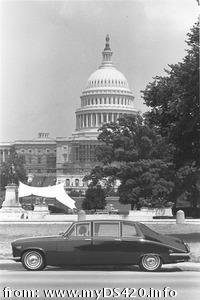
|
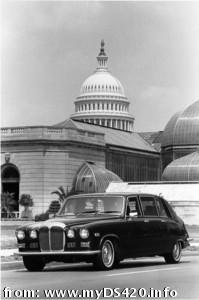
|
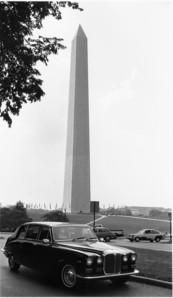
|
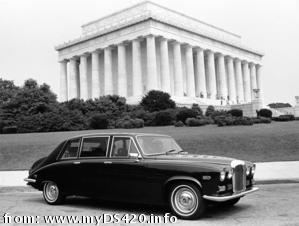
|
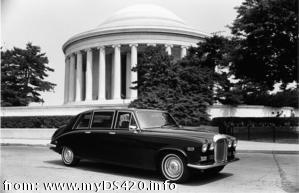
|
In 1982 a project was started to make the DS420 fit for sale on the US market. At about the same time plans arose to incorporate a few modifications that were commonly applied to limousines sold to the Middle East into the standard product for the 1983 model year: uprated cooling and air conditioning, manual choke, and modified door handles/locks. It was decided to start the American limo project from this point. It was also made an explicit goal to incorporate more Series 3 and XJ-S components, to provide better bulkhead and transmission tunnel isolation, and to change the occasional seats to rearward facing.
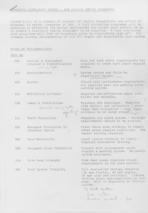 In November 1982 a preliminary list of non-compliance and
"likely compliance but further test required" was prepared.
This assumed the incorporation of fuel injection, where
standard DS420 used carburettors until the model was discontinued in 1992,
and an evaporative loss system.
The list contains a few points that would surprise no DS420 owner,
e.g. that the demist/defrost system was tested
and failed by a significant margin,
and that the screen wash/wipe was likely to require modifications.
Warning systems would have to be added for brake operation,
safety belts use and theft prevention.
Head restraints, strengthening beams in the side doors,
and a reinforced rear bumper would have to be added as well.
Much more serious was the fact that the front facia
might not meet the hand reach requirements,
and would probably not meet the head impact testing requirements,
and that the fuel system would probably not meet
the requirements of the "rollover" test (imagine this!).
Head lamps and other lighting issues had to be adapted to US specs,
including the problem that the rear lamps were unlikely to be large enough.
A hand-written note on one of the copies in the JDHT archive
marks the latter as a major change.
And, last but not least, all that nice looking chrome on the screen wipers
had to be replaced by non-reflective material.
Apart from the above issues the document contains
some 20 points recommended for further testing.
The document is shown on the right.
In November 1982 a preliminary list of non-compliance and
"likely compliance but further test required" was prepared.
This assumed the incorporation of fuel injection, where
standard DS420 used carburettors until the model was discontinued in 1992,
and an evaporative loss system.
The list contains a few points that would surprise no DS420 owner,
e.g. that the demist/defrost system was tested
and failed by a significant margin,
and that the screen wash/wipe was likely to require modifications.
Warning systems would have to be added for brake operation,
safety belts use and theft prevention.
Head restraints, strengthening beams in the side doors,
and a reinforced rear bumper would have to be added as well.
Much more serious was the fact that the front facia
might not meet the hand reach requirements,
and would probably not meet the head impact testing requirements,
and that the fuel system would probably not meet
the requirements of the "rollover" test (imagine this!).
Head lamps and other lighting issues had to be adapted to US specs,
including the problem that the rear lamps were unlikely to be large enough.
A hand-written note on one of the copies in the JDHT archive
marks the latter as a major change.
And, last but not least, all that nice looking chrome on the screen wipers
had to be replaced by non-reflective material.
Apart from the above issues the document contains
some 20 points recommended for further testing.
The document is shown on the right.
A limousine was modified to meet US specification, and sent over to perform technical tests. This preliminary car was codenamed "XDM65/1", and I have not found more specific information such as vehicle number (it probably was car 200377 or 200423). In September 1983 it was reported to have covered 7000 miles: in San Francisco for hill climbing ("restarts on the steeper hills were satisfactory where other vehicles failed already"), in the Arizona desert for high ambients, in Houston for high humidity and in New York for durability. Despite an impressive list of small problems and failures the report calls the test a success. But what about this one (that I -hjt- recognise from one of my own limos): "under certain critical conditions of speed and load the propshaft would foul and this problem also occasionally occurred during hard acceleration". Some of the other problems were: local overheating near a fuel pump, many issues with the airco unit, and some misbehaviour of the cruise control. Praise was given to the new Michelin 235/70 tyres, the cruise control, a new Bosch alternator, the Series-3 wiper system, and the new "Kiekurt" door locking.
From other notes it is clear that this car was back in the UK in November 1983, and, four years later (October 1987), that it was due to be scrapped. The latter note is directed to Jaguar USA, and offers a few special parts "which may be of use to you in maintaining the 2 limousines presently in use at Leonia" (see below).
By the end of June 1983 the production of the first demonstrator limousine started: painting in July, build in August and September, October for the non-destructive tests, 4000 mile emission certification in November and December, and shipping to Jaguar USA in Leonia NJ near the end of year. Necessary modifications to the "body in white" were among others: XJ40 petrol tank floor panel to be fitted, RH petrol filler to be deleted, spare wheel well to be repositioned to front of boot floor, bulk head to be modified to accomodate modified heating, new door handles to be fitted, and a plinth to be fabricated for the new tail lights. These points were discussed with the Park Sheet Metal company where the DS420 bodies were assembled, and with Motor Panels of Birmingham as they produced many of the body components.
It was envisioned that high-end livery companies would be the most promising market segment. Corporate executives and wealthy private customers were also considered, but reasons such as the non-availability of a specialised sales force made Jaguar decide to focus on the livery market. Carey Limousines, one of the largest limousine operators in the US, was approached to test the DS420 in their operational fleet. The above-mentioned demonstrator limousine (blue, VIN DWV2344FC200512 or DWVTN4FC200512) was made available to Carey, and shortly thereafter a sister car (red, VIN DWV2343FC200565 or DWVTN4FC200565) followed. It was effectively the first of these that was auctioned at Amelia Island in 2008, and had attracted Bob Boston's attention there.
Carey Limousines used the cars for approx. 1.5 years, in various cities of the US. Surveys were carried out on drivers and on passengers. In August 1985, one of the vehicles had accumulated 20,000 miles, and the other 14,000. Even though plans existed to extend the testing period until both vehicles had done 20,000 miles each, a meeting was held in Leonia to make up the balance up to that point.
The passenger survey in general brought much praise: "a real head turner,
excellent look, very classy and elegant, easy to enter and exit,
beautiful styling, a very pleasant car".
The main point of criticism was that a company of more than three people
could not be carried comfortably.
The driver survey, comparing the Daimler mainly against Cadillac and Lincoln,
was much less favourable: "too many keys, difficult placement
of keys and controls, rear visibility poor, driver compartment very cramped,
cannot make short radius turns, steers very hard at low speeds,
jump seats uncomfortable": "there is too much wrong with this Daimler"!
From a technical point of view
these cars indeed had not done their job too well:
a blown engine needed replacement, a front windscreen had cracked,
a water pump belt had broken, head gasket problem,
dashboard and cocktail cabinet veneer cracked, etc.
Too much for two brand new, low mileage vehicles.
Apart from that: repair periods in the range of 3 to 5 weeks had
been all too frequent. Dealer knowledge and parts availability
were blamed for this, but for a self employed driver
(as Carey had many under contract) this would be a lethal business case.
Carey Corporation, present at the meeting, had the opinion that insufficient mileage was amassed for a final judgement. But the down time experienced with the two test vehicles required action to be taken up with the dealers immediately. They felt that a void in the market could be filled with this limousine, in their case possibly going between 150 and 300 vehicles per annum. Most probably they were not aware of the fact that 200 limousines was the total yearly production at that time.
The Leonia management advised that the timing of the introduction in January 1987 would coincide badly with the planning to launch the XJ40. There was also concern that many of the problems currently being experienced with the XJ6 had shown up on the tested limousines as well, and insufficient assurance as to the reliability was felt. Parts availability would probably prevent dealers from reacting fast enough to problems, and at 75,000 miles, which was the typical write off time, the condition might be too suspect for a proper resell. Finally, the long term future of the limousine in the hands of the decision makers at Browns Lane gave reason for concern.
The verdict at that day was formulated by the Leonia management: "it would not be recommending the introduction of the Daimler limousine for the USA market to the Product Policy Committee". The American Limousine project had died in its infancy.
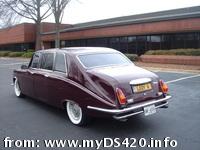 |
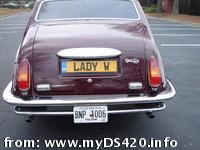 |
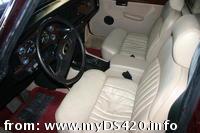 |
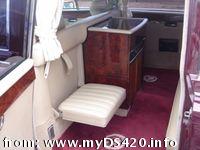 |
Clicking on these images brings up a gallery with many photos of the red demonstrator car. |
Jaguar USA kept both cars for a few years, and eventually sold them off. Bob Boston didn't buy car no. 200512 (blue) at the 2008 auction in Amelia Island. The auction price was $68,000. It turned up again for sale in 2013; at the beginning of this article we showed links to the auction webpages. It still was accompanied by the "built for Royal use in North America" and "not initially built with a rear trunk" description inherited from the first auction catalogue. Later, Bob had the opportunity to buy the second car, no. 200565 (red), and a number of photos contributed by him are shown with this article. Currently (2021), the car is owned by club member Scott Harrington in Wickford, Essex.
Thank you: Anders Clausager, Faye McLeod & Karam Ram of JDHT, Bob Boston, Scott Harrington, and John Quilter of Jaguar USA Ltd.
Reference: a few words about the project. including an estimate that the price in the US would be US$ 55,000.- approx., are on the last page of this magazine article. which concludes: "Soon Daimler limos will be running around on U.S. roads".